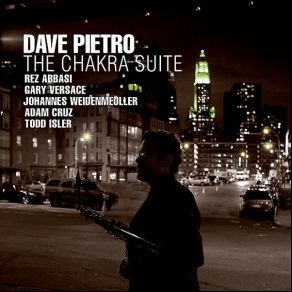The Chakra Suite
Download links and information about The Chakra Suite by Dave Pietro. This album was released in 2008 and it belongs to Jazz genres. It contains 8 tracks with total duration of 54:02 minutes.

|
|
|---|---|
| Artist: | Dave Pietro |
| Release date: | 2008 |
| Genre: | Jazz |
| Tracks: | 8 |
| Duration: | 54:02 |
| Buy it NOW at: | |
| Buy on iTunes $7.92 | |
Tracks
[Edit]| No. | Title | Length |
|---|---|---|
| 1. | Muladhara (1st Chakra) | 7:51 |
| 2. | Ajna (6th Chakra) | 7:25 |
| 3. | Manipura (3rd Chakra) | 6:32 |
| 4. | Anahata (4th Chakra) | 8:06 |
| 5. | Svadhisthana (2nd Chakra) | 6:33 |
| 6. | Vishuddha (Intro) | 2:24 |
| 7. | Vishuddha (5th Chakra) | 7:08 |
| 8. | Sahasrara (7th Chakra) | 8:03 |
Details
[Edit]Dave Pietro was commissioned by Chamber Music America's New Works: Creations and Presentation Program to create The Chakra Suite, which gave him the incentive to come up with something that could be explained conceptually. The concept turned out to be basing a series of compositions on the seven chakras, or body centers, of yoga. In Bill Mikowski's liner notes, Pietro acknowledges that this was no more than an organizing principle, which is probably just as well, since his purpose was not to come up with music to perform yoga by. Nor did he follow the strict order of the chakras, which go from the more earthy to the more ethereal, since, in musical terms, that would have meant beginning with more vibrant music and proceeding to calmer playing. Instead, he mixed them up to create an album in which, as usual, an uptempo number tends to be followed by a ballad, which is followed by another uptempo number. In fact, as a listener, one can simply throw all this out the window. Simply put, The Chakra Suite is an album on which Pietro mixes post-bop jazz with traditional Indian and Brazilian music influences. To do so, he uses a band willing to add some unusual sounds to create this hybrid. Guitarist Rez Abbasi, for instance, switches to a sitar guitar on "Vishuddha," while pianist Gary Versace turns to accordion to get a more Brazilian feel in "Svadhisthana." Todd Isler uses all manner of Indian and Brazilian percussion. Pietro himself, as he has on previous albums, employs not only soprano and alto saxophones, but also a 1927 C-Melody sax, as well as an F-Mezzo sax, to get different musical colors. The resulting music is still identifiable as jazz, however, and should not require any more aesthetic stretching for listeners than it does physical stretching, despite the exotic concept and track titles.